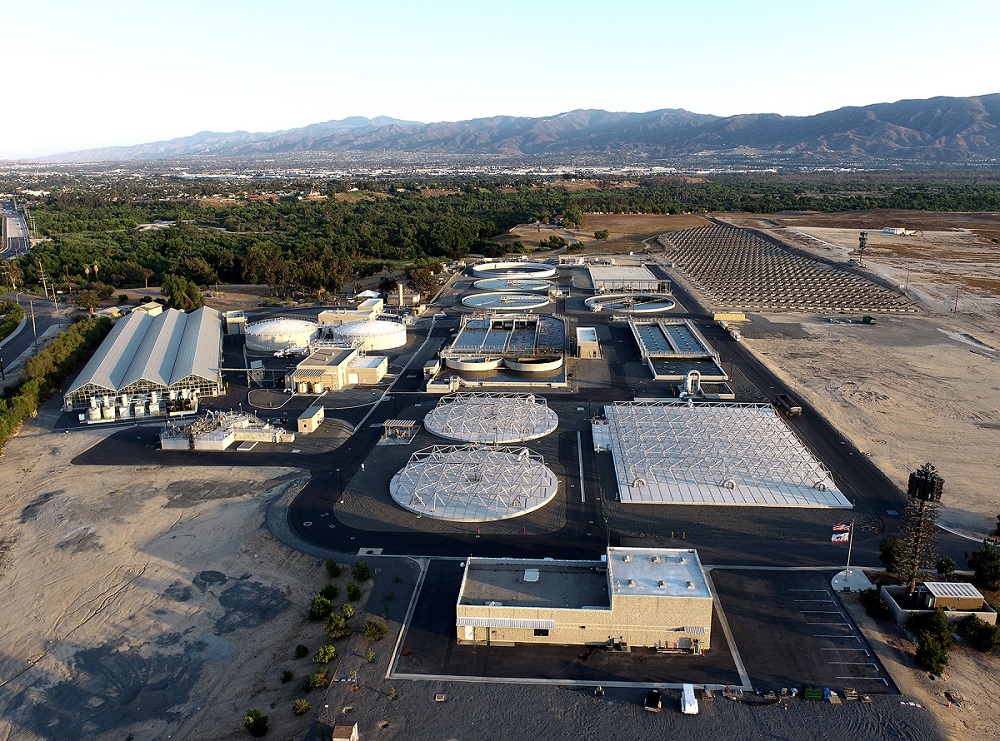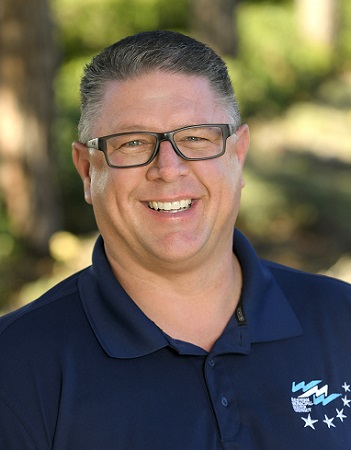
Western’s Eastvale water resource recovery facility (photo by Western MWD)
For member Tony Pollak, the pandemic and sudden chlorine shortage that hit this spring have pushed his operations team to redouble their efforts. Tony is the Assistant Deputy Director of Operations for Western Municipal Water District in Riverside County.

Tony Pollak, Assistant Deputy Director of Operations, Western Municipal Water District
In late May, the District’s chlorine supplier informed them a west coast shortage would delay deliveries. The last three months have been a struggle as Tony and his team work to keep enough chlorine on hand for Western’s multiple treatment facilities. Both of Western Municipal Water District’s Wastewater treatment plants are required to disinfect 100% of the flow.
So far, the team has stretched the limited supply. Reaching out to numerous vendors, buying temporary totes, even driving small quantities back and forth between plants on opposite sides of the county have helped them get through it. During this time, staff engaged the Department of Homeland Security and EPA for federal assistance.
The national chlorine shortage has roots in an unprecedented series of disruptions: chemical plants in Texas and Louisiana suffered storm damage, a plant in Washington state experienced a transformer fire, a rail bridge burned down in the Dixie fire, and a national truck driver shortage is causing delivery delays.
Has the three-month ordeal changed your perspective on chlorine and the supply chain?
Being in the industry for 30 years, I’ve never run into this issue. I’m starting to look at this: is this a one-off or is this something that’s going to reoccur over and over again?
I like to think it’s one-off, but overall, it has made me start to think about who our vendors are, what the relationships are, and what the backups are.
Vendors frequently want exclusivity. If you enter into a contract with chlorine supplier A, it wants to be the only supplier. Which I get. Exclusivity is okay, but a threshold must be included so that if supply is low, agencies have the ability to reach out into the marketplace to secure the necessary product essential to preserving public health.
It’s starting to reshape my thought process on agreements: what’s good for the agency, and what is the vendor trying to accomplish. Both need to be in harmony.
You’ve tapped into the EPA’s 1441 process which is part of the Safe Drinking Water Act and provides federal assistance to prioritize chemical shipments. How has that process gone?
The thought of an EPA application sounded daunting, but truth be told, it was no big deal. The 1441 application is seven pages in length and not difficult to complete. In total, it probably took less than 30 minutes!
A few days later, I received a phone call from the EPA wanting to walk through our application to better understand the challenges and ask follow up questions. The EPA staff were wonderful and friendly. Our goals are the same – to serve the public.
It’s been an easy process, although it takes quite a bit of time. The EPA needs to approve the application, then it goes into the Federal Registry for 30 days. In our case, it is being shortened to 14 or 15 days. From there, it moves to the Department of Commerce for its process. We’re still at it – this is not like you turn in your application and a week later a vendor ships you product.
Were there any procedures you had in place that helped with the shortage?
One of the takeaways I got out of this is chlorination controls. Over the years, I’ve spent a lot of time working on chlorination controls and always trying to make them better. I’ve been able to reduce our daily consumption by 400 gallons.
If we hadn’t done that, guaranteed we would have run out of chlorine.
This is just something we all need to challenge ourselves to do: always look to be bigger and better. How can we make improvements to be more efficient?
I’m never giving up on this. If we can tweak a process and save one gallon a day, that’s better than nothing. It saves customer dollars, and overall, it’s doing the right thing. Plan ahead and plan early.
If you had the ear of the EPA and US chemical leaders, what would you say?
I think it’s prioritization of needs. As a private company, you have the right to sell to whoever and make a profit. A private business wants to sell for the highest price.
We have an obligation to the communities we serve. As a nation, I think water and wastewater should supersede other manufacturing during a shortage. To protect public health and offer reliable service, we can come to an agreement that a certain percentage must be available for water and wastewater treatment at all times.
Agencies like Western are relying on chlorination for disinfection of drinking water, and we have WRRFs that discharge into sensitive wetlands where people recreate and we don’t want to pollute those waterbodies.
There are no easy answers. We could reduce chlorine demand by producing less recycled water, but that shifts demand to the drinking water side which would become a double whammy! You’re still using chlorine as well as using a precious resource we’re fighting to use as efficiently as possible.
I think its mindfulness about what our sector does. I don’t know that the chemical sector or regulators fully thought through some of our chlorine demands or the essential services that it maintains for our communities. One regulator mentioned this only being a “water” issue and not affecting the wastewater sector… I would venture to guess wastewater treatment consumes more chlorine than water treatment per unit treated.
From what I understand, the water and wastewater segment only represents about 4% of the chlorine market, so we’re not the big fish. It’s only 4% and the chemical industries need to ensure that 4% is always available.
Was mutual aid effective during this emergency?
A chlorine shortage is an interesting situation. Regardless of mutual aid, chlorine is a consumable that has a very short shelf life. There was no way for agencies to help one another because the chlorine shortage was affecting every one of us.
As we got into the 1441 application, it was interesting because I was having conversations with Department of Homeland Security and the EPA and then I would get an email or a call from the State Water Board, ‘Hey, we’re understanding you’re going through a 1441 application, do you mind if we join your calls so we can understand this process?’
I think as regulators became aware, they wanted to dive in and understand. It was new to everybody.
But how do you react? Unlike a fire department battling a fire and knowing what to do, we were facing a chlorine shortage that nobody has experienced in at least 30 years.
What are some lessons wastewater professionals should take from this?
First and foremost, it’s developing relationships with vendors and having multiple suppliers. It will require the wastewater industry to band together to say, ‘We understand the importance of private business, but they need to understand the pressures we’re under to protect public health.’
Getting vendors and other key stakeholders to understand our pressures while also working to understand their pressures will help us work together and manage these supply challenges. They can’t survive without us, and we can’t survive without them.
A second lesson learned is the importance of proactive communication with Regional Boards and frequent updates offered. Initially, the shortage caught the attention of water regulators. They heard we had some potential drinking water challenges, but the wastewater folks were left in the dark.
It was surprising people were saying this is a water issue when the wastewater side is the larger consumer of the product between the two sectors. I think that was eye-opening for regulators.
Communication and getting out in front of it with your regulators early are important, so they know the organizations are doing their due diligence. They know we are working hard to ensure every option is looked at to source product. This is a dynamic situation. There are lots of things in the background that have to line up perfectly to get supplies across the country. By working together, communicating and exploring innovative solutions, I am hopeful these essential chemicals can be prioritized for water and wastewater.